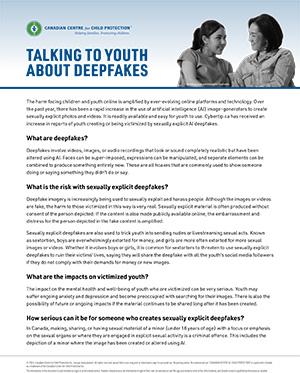Online Harms: AI and Deepfakes
What are deepfakes?
Deepfakes involve videos, images, or audio recordings that look or sound completely realistic but have been altered using AI. Faces can be super-imposed, expressions can be manipulated, and separate elements can be combined to produce something entirely new. These are all hoaxes that are commonly used to show someone doing or saying something they did not do or say.
What is the risk with sexually explicit deepfakes?
Deepfake imagery is increasingly being used to sexually exploit and harass people. Although the images or videos are fake, the harm to those victimized is very real. Sexually explicit material is often produced without consent of the person depicted. If the content is also made publicly available online, the embarrassment and distress for the person depicted in the fake content is amplified.
Sexually explicit deepfakes are also used to trick youth into sending nudes or livestreaming sexual acts. Known as sextortion, boys are overwhelmingly extorted for money, and girls are more often extorted for more sexual images or videos. Whether it involves boys or girls, it is common for sextorters to threaten to use sexually explicit deepfakes to ruin their victims’ lives, saying they will share the deepfake with all the youth’s social media followers if they do not comply with their demands for money or new images.
How serious can it be for someone who creates sexually explicit deepfakes?
In Canada, sexually explicit material of a minor (under 18 years of age) with a focus or emphasis on the sexual organs or where they are engaged in sexually explicit activity is a criminal offence. This includes the depiction of a minor where the image has been altered using AI.
How to talk with youth about deepfakes:
- With a curiosity to understand what youth are encountering or have heard about AI, ask them what they know about it. Build on what they share to explain AI-generated content.
- Ask how youth think deepfakes could be harmful and what the risks could be. Offer information about how sexually explicit deepfakes can be misused to harm youth and discuss the seriousness involved.
- Talk about the real impacts on someone who is victimized by someone else creating a sexually explicit deepfake images or video of them — even though the content isn’t real.
- Explain youths’ rights to safety, privacy, bodily autonomy, and sexual integrity. If someone violates their rights, share with them that you want to know so you can help them. Let them know you are in their corner and will be there to walk with them through tough situations.
-
Share services that can help if a sexually explicit deepfake has been created, such as:
- Cybertip.ca
- NeedHelpNow.ca
- Law enforcement
-
Youth benefit from opportunities to solve problems, practice decision making, and apply their learning to solving real challenges. Generate “what if” scenarios. Discuss how to deal with difficult situations online and practice possible answers to increase the likelihood they will be able to respond safely and tell someone if something concerning happens online. Ask things such as:
- If someone created a sexually explicit photo of you using AI, who could you turn to for help?
- If someone threatened to send out a sexually explicit photo of you (whether AI-generated or not) and demanded that you pay them money to stop, what would you do?
- If a friend thought it was funny and wanted you to create AI-generated pictures of someone else, what would you do? Why?
Report to Cybertip.ca if your youth is being targeted online.
